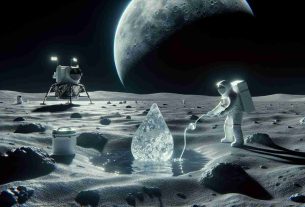A vast reservoir of liquid water lies hidden beneath the surface of Mars, trapped within cracks of igneous rocks about 11-20 kilometers below the barren terrain. This discovery opens up the possibility of microbial life surviving at such depths, as indicated by recent seismic data analysis.
Previous Mars conditions allowed for rivers, lakes, and seas to exist on the planet, leaving behind remnants of water that still flow deep underground today. Unlike the frozen water found at the planet’s poles and below the surface, this newfound reservoir maintains its liquid form due to the planet’s internal heat.
Scientists, led by planetary experts from the University of California, utilized measurements of seismic waves to understand the composition of rocks and identify the presence of deep-water fissures. The insights gained from the InSight robot mission shed light on the potential for sustaining life in extreme Martian environments.
While the vast liquid water reservoir presents an enticing resource for potential future human missions to Mars, the impractical depth at which it is located poses significant challenges for extraction and utilization. Nonetheless, this groundbreaking discovery fuels excitement and curiosity about the hidden mysteries of the Red Planet.
Delving Deeper into the Mysteries of Mars
Scientists continue to unravel the secrets of Mars, with each new discovery shedding light on the planet’s enigmatic past and potential for harboring life. While the recent revelation of a vast reservoir of liquid water beneath Mars’ surface has captured imaginations, there are still many unanswered questions and challenges that researchers face in exploring the depths of the Red Planet.
Key Questions:
1. What are the implications of microbial life surviving in the deep-water fissures of Mars?
– While the discovery of liquid water raises the possibility of microbial life, further studies are needed to understand the nature of any potential Martian organisms and their adaptation to extreme environments.
2. How can we effectively extract and utilize the hidden reservoir of liquid water for future missions?
– The practical challenges of accessing water located 11-20 kilometers below the Martian surface present significant engineering hurdles that must be overcome for any potential human missions.
3. What role did past Martian conditions play in the formation of the deep-water reservoir?
– Understanding the geological history of Mars and the processes responsible for creating and maintaining the liquid water reservoir can provide valuable insights into the planet’s evolution.
Key Challenges:
– Extraction and Utilization: The impractical depth of the liquid water reservoir poses significant challenges for extraction, storage, and utilization, making it a formidable obstacle for any future human missions to Mars.
– Life Detection: Detecting potential microbial life in the deep-water fissures requires advanced technology and precise instruments to analyze samples and establish the presence of living organisms.
– Environmental Factors: Understanding the dynamics of the Martian subsurface environment, including temperature fluctuations, pressure changes, and chemical composition, is crucial for assessing the potential habitability of the deep-water reservoir.
Advantages and Disadvantages:
Advantages:
– Potential for Life: The discovery of liquid water beneath Mars’ surface increases the likelihood of finding microbial life forms that could provide insights into the possibilities of extraterrestrial life.
– Scientific Exploration: Studying the deep-water reservoir offers a unique opportunity to investigate the geological history and hydrological processes of Mars, expanding our understanding of the planet’s past and potential future.
Disadvantages:
– Technical Challenges: Accessing and utilizing the liquid water reservoir at such depths presents significant engineering challenges that may hinder the feasibility of extracting water for practical use.
– Cost and Resources: Developing the necessary technology and infrastructure for exploring and studying the deep Martian subsurface requires substantial investment and resources, which may limit the scope of future missions.
As scientists and space agencies continue to probe the depths of Mars, the allure of unlocking its hidden mysteries and potential for life remains a driving force in planetary exploration. The groundbreaking discovery of liquid water beneath the Martian surface heralds a new chapter in our quest to understand the Red Planet and its secrets.
Explore more about Mars and its mysteries on the official NASA website: NASA.



